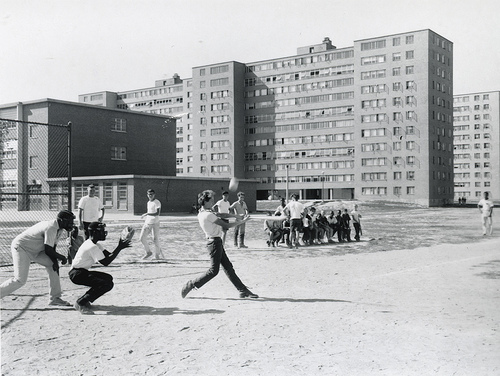Today I want to tell two stories, this time not of constructing new exciting architecture but instead of demolition!
Demolition, on the one hand, seems like an essential part of a building's life cycle, but when it comes to important architecture milestones, it makes you wonder why these buildings warrant such an ending. This month (March, 16th), it was exactly 40 years since the first building of Pruitt-Igoe was demolished by implosion in 1972.
The now infamous St. Louis pulic development was a housing marvel of its time, consisting of 33 11-story apartment buildings designed by Minoru Yamasaki -- later to become the architect of the tragically famous World Trade Center. Popular belief for the development's demolition lie with rising crime, neglected facilities, and fleeing tenants that the existence of 'bad' modernist architecture seems to attract. Notably when the first stage of demolition at Pruitt-Igoe was completed, Charles Jencks, the prominent architectural theorist, declared July 15th 1972 the day that "Modern Architecture died".

Image: www.pruittigoenow.org
However, an article by Dante A. Ciampaglia, for Architectural Record, about the 2011 documentary The Pruitt-Igoe Myth sheds some light on the feelings of the displaced people who had been living there that makes the story of the unfortunate housing development a little different:
"...Freidrichs (documentary director) captures the voices and memories of five former Pruitt-Igoe residents. They tell stories of jubilation when they're assigned an 11th floor apartment (their "poorman's penthouse") and when they see rows upon rows of windows bejeweled with Christmas lights..."
See a slideshow of other buildings of architectural or historical merit that faced demolition or are threatened with it. Second story comes after the break.
The second story I would like to bring up is that of Toyo Ito's unusual White U-House built in 1976 in the centre of Tokyo. The house was designed for the architect's older sister, who had just lost her husband.
The widow requested a house for her and her young daughters where they could enjoy the close contact with the soil and plants that their former home had lacked, but also some privacy and communication between the family members. The idea of the house evolved over the client's conversations with the architect and thus the U-House came to be. The bent linear space of the house was squeezed on both ends into dark corridors which ended on the one side at the girls' rooms, and on the other -- passing through the kitchen and bathroom - at the mother's bedroom. Because of the specific geometry the living space needed no walls to separate playing, dining and meditating. All surfaces of the multi-use space, including the carpet were white which reinforced the powerful light effects coming from the few carefully positioned and shaped accent openings. All these characteristics created an abstract, almost two-dimensional space like a screen upon which only the inhabitants' shadows and lives were projected.

Image: Toyo Ito & Associates
The story, as told by Toyo Ito, reaches its conclusion twenty-one years after the completion of the house, when the family was ready to re-establish its links with the outside world. The older daughter who moved out first later claimed she had never thought of whether or not it was comfortable to live in the house, although she refers to the house as a coffin. The mother also moved out, but being a musicologist she had enjoyed the music echoing on the bare walls in the old house. The youngest daughter was the last one to move out. She felt she had developed certain sensitivity for aesthetics in this house and later she became a museum director. The house was demolished in 1997.
Clearly a lot has been written and said on Pruitt-Igoe and modernist buildings' supposed lack of understanding of life. And the U-house, you might say, was pre-conceived as a mourners' house so it was only logical to run it down after it finished serving that purpose. But what it is that I find so interesting about these stories is the fact that they illustrate the emotional relationship between buildings and their inhabitants. The reasons that they have been torn down are as emotive as the reasons to build them in the first place. The life of these buildings are not purely dictated by demographics, planning requirements or structural issues... they are structures with their own emotional life story.
